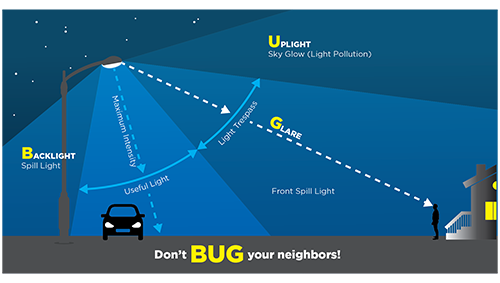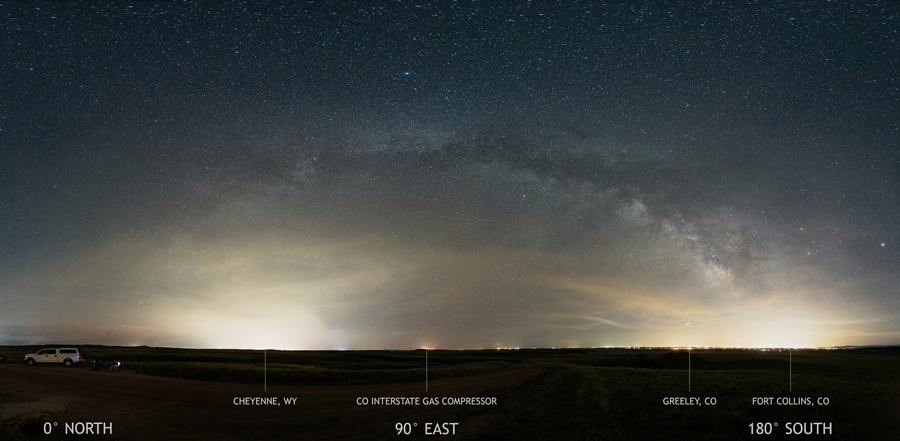Overview#
Maintaining the ability to see night sky stars and increasing the use of best practices in outdoor lighting go hand in hand. As Fort Collins grows there will be more commercial and residential outdoor lighting.
In an effort to support safety, energy conservation, a healthy eco-system, and innovation the City is supporting a Night Sky Initiative of outdoor lighting best practices that eliminate light glare, reduce light trespass, minimize light pollution, conserve energy and protect the natural environment.
Through sustainable efforts the City seeks to:
- Maintain safety and security
- Develop and implement best practices in outdoor lighting
- Reduce light pollution
- Support human and ecological health
What Is Light Pollution?#

Light pollution is a side effect of urbanization and the increase and necessity for outdoor lighting. While outdoor lighting is critical in many situations, the inappropriate or excessive use has negative effects. Common terms associated with light pollution include:
- Glare – excessive brightness that causes visual discomfort
- Skyglow – brightening of the night sky over inhabited areas
- Light trespass – light falling where it is not intended or needed
- Clutter – bright, confusing and excessive groupings of light sources
Preventing light pollution results in energy and cost savings as well as better lighting of the things we need to see at night.
Local Regulations on Exterior Lighting#
The City of Fort Collins regulates exterior lighting through different codes. The Land Use Code regulates new or changes to existing multi-family and commercial developments. For more information, see: https://www.fcgov.com/developmentreview/lighting-regulations
Building Codes also address outdoor lighting for both commercial and residential uses by requiring down directional and fully shielded luminaires with a nominal color temperature of no greater than 3000 Kelvin. All fixtures must comply with these requirements. For more information see: https://www.fcgov.com/building/
Planning a Retrofit? If you are planning a retrofit, keep in mind all codes require fully shielded fixtures. Additionally, if your retrofit is a commercial or multi-family development, more than likely your project will be required to undergo (at minimum) the Minor Amendment Process for approval. For more information about the Minor Amendment Process see: https://www.fcgov.com/developmentreview/process
Anytime you're installing or replacing a light fixture consider the 6 best practice principles listed below:
- Light only where you need it
- Light only when you need it
- Shield and recess lights and direct them downward
- Use the minimum amount of light needed
- Select energy efficient lighting
- Select lamps with warmer colors
Why Is Color Important?#

Light can have subtle, and not so subtle, impacts on humans and wildlife. Selecting an appropriate color temperature for lighting needs is important. During high daylight hours (7am-3pm) whiter light matches the natural sunlight in the outdoor environment. Similarly, during non-daylight hours (4pm-6am) warmer colors will better match the natural environment and won't be as wakeful and stimulating to human and animal brains.
More is being learned about blue light and studies show that blue light in dusk through evening hours can have negative effects on humans and wildlife.
How Bright Are We?#

Fort Collins average light pollution values are 20 times brighter than natural conditions. This means that a typical sky in the Fort Collins is 20 times brighter than that of a sky with no light pollution. The lowest levels are 7.5 times brighter than natural and the maximum is around 35 times brighter.
Within natural areas and open spaces the average night sky is 4 times brighter than natural conditions. The darkest skies found in Soapstone Natural Area are just 1.1 times darker than natural conditions and offer outstanding views of the cosmos.